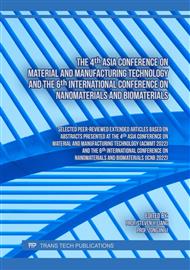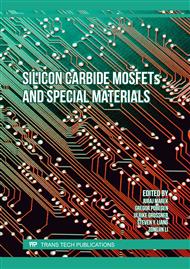[1]
US Department of Health and Human Services, Toxicological Profile for Copper, 2004.
Google Scholar
[2]
B.O. Anyanwu, A.N. Ezejiofor, Z.N. Igweze, O.E. Orisakwe, Heavy metal mixture exposure and effects in developing nations: An update, Toxics. 6 (2018) 65.
DOI: 10.3390/toxics6040065
Google Scholar
[3]
M. Rehman, L. Liu, Q. Wang, M.H. Saleem, S. Bashir, S. Ullah, D. Peng, Copper environmental toxicology, recent advances, and future outlook: a review, Environmental Science and Pollution Research. 26 (2019) 18003–18016.
DOI: 10.1007/s11356-019-05073-6
Google Scholar
[4]
World Health Organization, Guidelines for Drinking-water Quality, 1st ed., World Health Organization Press, Geneva, Switzerland, 2006.
Google Scholar
[5]
Department of Environment and Natural Resources, DENR Administrative Order No. 2016-08: Water Quality Guidelines and General Effluent Standards, Quezon City, 2016.
Google Scholar
[6]
Department of Environment and Natural Resources, DENR Administrative Order No. 2021-19 - Updated Water Quality Guidelines (WQG) and General Effluent Standards (GES) for Selected Parameters, 2017.
Google Scholar
[7]
Department of Health, Administrative Order No.2017-0010 - Philippine National Standards for Drinking Water, 2017. http://www.doh.gov.ph
Google Scholar
[8]
W.S. Zhong, T. Ren, L.J. Zhao, Determination of Pb (Lead), Cd (Cadmium), Cr (Chromium), Cu (Copper), and Ni (Nickel) in Chinese tea with high-resolution continuum source graphite furnace atomic absorption spectrometry, J Food Drug Anal. 24 (2016) 46–55.
DOI: 10.1016/j.jfda.2015.04.010
Google Scholar
[9]
A.B.M. Helaluddin, R.S. Khalid, M. Alaama, S.A. Abbas, Main analytical techniques used for elemental analysis in various matrices, Tropical Journal of Pharmaceutical Research. 15 (2016) 427–434.
DOI: 10.4314/tjpr.v15i2.29
Google Scholar
[10]
S. Unser, I. Bruzas, J. He, L. Sagle, Localized surface plasmon resonance biosensing: Current challenges and approaches, Sensors (Switzerland). 15 (2015) 15684–15716.
DOI: 10.3390/s150715684
Google Scholar
[11]
D. Vilela, M.C. González, A. Escarpa, Sensing colorimetric approaches based on gold and silver nanoparticles aggregation: Chemical creativity behind the assay. A review, Anal Chim Acta. 751 (2012) 24–43.
DOI: 10.1016/j.aca.2012.08.043
Google Scholar
[12]
N. Ratnarathorn, O. Chailapakul, C.S. Henry, W. Dungchai, Simple silver nanoparticle colorimetric sensing for copper by paper-based devices, Talanta. 99 (2012) 552–557.
DOI: 10.1016/j.talanta.2012.06.033
Google Scholar
[13]
K.S. Prasad, G. Shruthi, C. Shivamallu, Functionalized silver nanosensor for colorimetric detection of Hg2+ ions: Facile synthesis and docking studies, Sensors (Switzerland). 18 (2018).
DOI: 10.3390/s18082698
Google Scholar
[14]
S.M. Stavis, J.A. Fagan, M. Stopa, J.A. Liddle, Nanoparticle Manufacturing-Heterogeneity through Processes to Products, ACS Appl Nano Mater. 1 (2018) 4358–4385.
DOI: 10.1021/acsanm.8b01239
Google Scholar
[15]
B.A.G. De Melo, F.L. Motta, M.H.A. Santana, Humic acids: Structural properties and multiple functionalities for novel technological developments, Materials Science and Engineering C. 62 (2016) 967–974.
DOI: 10.1016/j.msec.2015.12.001
Google Scholar
[16]
E.C.R. Lopez, M.A. Zafra, J.N.L. Gavan, E.D.A. Villena, F.E.P. Almaquer, J.V.D. Perez, Humic Acid Functionalized - Silver Nanoparticles as Nanosensor for Colorimetric Detection of Copper (II) Ions in Aqueous Solutions, Key Eng Mater. 831 (2020) 142–150.
DOI: 10.4028/www.scientific.net/KEM.831.142
Google Scholar
[17]
S. Mourdikoudis, R.M. Pallares, N.T.K. Thanh, Characterization techniques for nanoparticles: Comparison and complementarity upon studying nanoparticle properties, Nanoscale. 10 (2018) 12871–12934.
DOI: 10.1039/c8nr02278j
Google Scholar
[18]
M. Klučáková, R. Kolajová, Dissociation ability of humic acids: Spectroscopic determination of pK a and comparison with multi-step mechanism, React Funct Polym. 78 (2014) 1–6.
DOI: 10.1016/j.reactfunctpolym.2014.02.005
Google Scholar
[19]
V.N. Mehta, J. V Rohit, S.K. Kailasa, Functionalization of silver nanoparticles with 5-sulfoanthranilic acid dithiocarbamate for selective colorimetric detection of Mn2+ and Cd2+ ions, New Journal of Chemistry. 40 (2016) 4566–4574.
DOI: 10.1039/c5nj03454j
Google Scholar
[20]
V. Manoharan, A. Ravindran, C.H. Anjali, Mechanistic Insights into Interaction of Humic Acid with Silver Nanoparticles, Cell Biochem Biophys. 68 (2014) 127–131.
DOI: 10.1007/s12013-013-9699-0
Google Scholar
[21]
B. Derjaguin, L. Landau, Theory of the stability of strongly charged lyophobic sols and of the adhesion of strongly charged particles in solutions of electrolytes, Prog Surf Sci. 43 (1993) 30–59.
DOI: 10.1016/0079-6816(93)90013-L
Google Scholar
[22]
E.J.W. Verwey, J.Th.G. Overbeek, Theory of the Stability of Lyophobic Colloids, Elsevier Publishing Company, Inc., Netherlands, 1948.
Google Scholar
[23]
H. Ohshima, The Derjaguin-Landau-Verwey-Overbeek (DLVO) Theory of Colloid Stability, Electrical Phenomena at Interfaces and Biointerfaces: Fundamentals and Applications in Nano-, Bio-, and Environmental Sciences. (2012) 27–34.
DOI: 10.1002/9781118135440.ch3
Google Scholar
[24]
G. Stando, P.M. Hannula, B. Kumanek, M. Lundström, D. Janas, Copper recovery from industrial wastewater - Synergistic electrodeposition onto nanocarbon materials, Water Resour Ind. 26 (2021).
DOI: 10.1016/j.wri.2021.100156
Google Scholar



